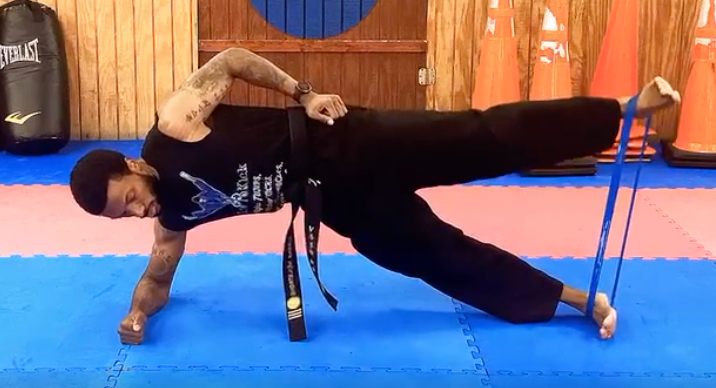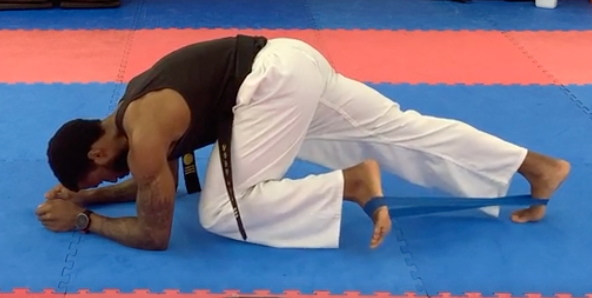I've been practicing taekwondo for 9 years, and I've been teaching for 6 years. I've seen beginners and black belts struggle with the same technical problems with their kicks. Why? Because all they do is kick, thinking that's the way to get better.
Now while quality repetitions build skill, your body has to be properly conditioned to enter, maintain, and produce force from key positions. You'll achieve this with intentional fitness and athletic training.
Below are some exercises that I recommend taekwondo beginners try if they want to have a chance at getting good at kicking.
The Shoulder Girdle
External Rotations
Despite taekwondo's emphasis on kicking, hand strikes are trained; this is for good reason. You want to be able to produce enough force in your punches and knife-hand strikes when striking your opponent, breaking a board, or doing bag work.
Push-ups are trained to increase the fitness of your hand striking muscles to punch harder.
Discover The Little Known Secrets For Unlocking Devastating KO Power!
Heavy hands are built doing these things...
Yet, an overemphasis on the anterior structures of the shoulder girdle from a lot of push-ups makes these muscles overactive. These are the anterior deltoid, pectoralis major, and triceps. It also makes their opposing muscles underactive. These are the infraspinatus, posterior deltoid, and rhomboids.
This is why a lot of practitioners' shoulders hurt. To enjoy your martial art pain-free, do this exercise to regain balance to your shoulder girdle along with your push-ups.
The Lumbo-Pelvic Hip Complex
Side Plank Abductions

When we kick, most of the time we are operating in the frontal plane (body is sideways). So why is it that many martial art classes focus on crunches and sit-ups? These are two of the most common and popular core exercises. But to become a better taekwondo practitioner, you must train the core in planes of motion that you normally use while kicking.
The side plank abduction fits the bill because it trains your obliques to help stabilize your trunk, like it would do when doing the roundhouse, side, and hook kicks (kicks performed when your body is sideways).
The stronger your obliques are in the frontal plane, the better chance you have of maintaining an erect torso when kicking; this is important from an aesthetic standpoint, because your body falling excessively in the opposite direction of your kick doesn't look good.
It's also important from a tactical perspective; if you have to lean excessively before kicking, you telegraph your intentions to your sparring partner.
Band Resisted Planks

The side plank abductions also have the added benefit of training your hip abductors: the muscles that raise the leg for kicks in the frontal plane.
When you do frontal plane kicks, your abductors work in concert with your obliques to produce dynamic stability, especially for multiple kicks.
The plank is a good exercise for kickers, because it trains your trunk to stabilize the spine in the sagittal plane (like kicks going in front of the body). Think about the front kick and axe kick. However, this plank variation is more specific to taekwondo practitioners because it trains hip flexion while your trunk stabilizes your spine.
When you do the front kick, your knee has to raise in front of your body; this is hip flexion. However, you don't want excessive motion from your spine while doing your kick; you want to stay stable. So, to train both abilities simultaneously, try the band-resisted planks.
This stability is one factor that differentiates elite Taekwondo athletes with sub-elite which you can read more in the article "Strength Training For Taekwondo."
Lower Extremities
Romanian Deadlift (RDL)
This exercise kills three birds with one stone. The first bird is hamstring flexibility. There are four main types of flexibility, and dynamic-active flexibility is one of them. When you lower the weight, the hamstrings are stretched. Now magic happens when you lift the weight.
Lifting the weight from the stretched position builds strength from the terminal ranges of motion, so your hamstrings get stronger and more flexible simultaneously! When this happens, you can access your flexibility spontaneously, instead of having to warm-up for 15 minutes first.
It has the added benefit of reducing hamstring injuries. Why? Because your elastic limit has been increased. When you try to kick too high for your current levels of flexibility, the brain registers those kicking heights as unsafe; this is why you feel the stretch reflex when you stretch too far.
That stretch reflex is a way of protecting your body from going into unsafe positions, so you don't get injured. But when you're strong enough in those positions, the brain registers those positions as safe; now you can use your flexibility in those ranges without that tension you normally feel when stretching.
James recommends exercises just like this instead of stretching to get more flexible.
The second benefit of this exercise is that it trains hip extension. One kick that most practitioners struggle to get right is the sidekick; they often favor knee extension (straightening the leg) and ignore hip extension (straightening the hip). So instead of a sidekick, they're executing roundhouse kicks.
The RDL trains the intermuscular coordination of muscles involved in hip extension. These include gluteus maximus (your butt, which is your prime hip extensor), and your hamstrings which synergizes hip extension (they help your butt straighten the hips).
When your body learns how to coordinate your hip extension muscles, it will translate to a proper sidekick.
The third benefit is trunk stabilization in the sagittal plane. We hit on this in the band-resisted plank, however the main movement is different. In the band-resisted plank, your trunk stabilizes your spine while your hip flexes (knee-to-chest).
In the RDL, your trunk stabilizes your spine while your hip extends. Think of the downward motion of your axe kick; that's hip extension. The upward motion would be hip flexion. Combining the trunk stabilization and hamstring flexibility of the RDL, and you'll be able to do your sagittal plane kicks (front, axe, and crescents) without compensation (hunching over when kicking).
Piecing It Together
Add the external rotations to your upper-body training sessions. Better yet, superset this exercise with your push-ups to make sure you're working the anterior and posterior structures of your rotator cuff.
Add the side plank abductions and band-resisted planks to your core workouts. This helps make sure your training functions specific to kicks in front of the body and to the side of the body.
Add the RDL to your lower-body training sessions to ensure your hamstring flexibility, hip extension, and core stability is trained to become a better overall kicker. If you train full-body, then make sure all the above exercises are trained two to three times per week.
You can kick until you're blue in the face, but training the movement pattern is just one piece of the puzzle. Sick of being blue in the face? Conditioning for Taekwondo has you covered.
Your muscles and joints have to be trained using certain exercises to kick better than you do now. After reading this, do you think you've been doing enough to become a better kicker?
Will you change your approach to training?


